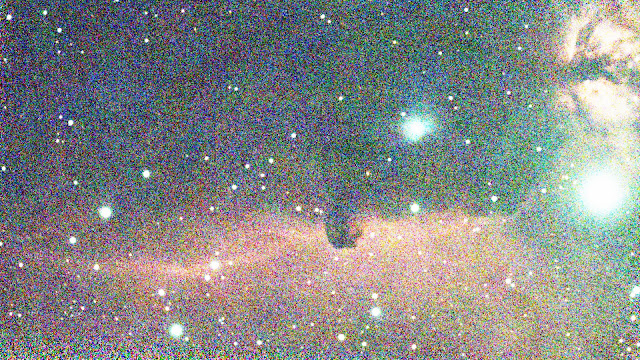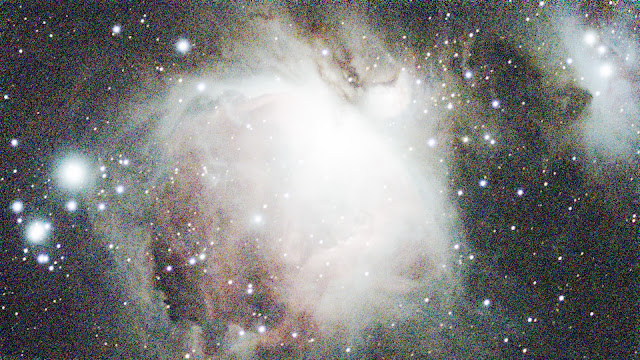in the Hawkesbury District of NSW, Australia
Friday, May 31, 2024
Unknown...
Billions and Billions of Stars...
 |
| NGC 3532 (Caldwell 91) : 11h 05m 12s, −58° 44′ 1″ |
Thursday, May 30, 2024
Minimalist Post-Processing...
Background
Having started learning about astrophotography at the beginning of 2024, it's been a bit of a wander through the various astrophotography 'rooms' trying different things. Each 'room' had its own attractions - but there are a great number of rooms. There is also a lot of 'advice' as to how, what and where astrophotography should be done. It is easy to be restrained from picking your own 'niche'.
A comment often heard from some quarters is 'why do astrophotography ?' After all, much better images could be downloaded from the 'net captured by professional telescopes. That's true - but that is missing the most important point (at least for me) - which is - those images are not my images. The wonderment that the photons from some object millions of light-years away have been captured in my backyard telescope and converted to pixels in my image is missing from a downloaded image.
I'm gradually finding my own 'niche' guided by some parameters...
- I know next to nothing about the night sky.
- Viewing through an eyepiece is not an option due to eyesight and posture issues.
- Polar aligning an equatorial mount is not an option due to eyesight, posture and light pollution (SCP doesn't have a Polaris). I tried and could never do it.
- Spending hours on post-processing with clever - but complicated - post-processing applications is not my idea of fun.
- My sky view is limited to the home block being almost covered by tall eucalypts and so about a 1/2 dozen different sites on the block are needed to get some coverage. Therefore, a permanent installation is not practicable.
Post-Processing Pain
Seestar S50 to the Rescue
 |
| Orion Nebula (M42) Processed Entirely with the Seestar S50 Phone App and Onboard Firmware |
I will explore this functionality further.
Wednesday, May 29, 2024
Supernova SN2024gy in NGC 4216 Fading...
Took advantage of a - mostly - clear sky last night to re-observe NGC 4216 using the Seestar S50 smart telescope to see how much the supernova (SN2024gy) had faded. The comparison below shows the difference between its brightness some 2 and a bit months ago at 11th March 2024 compared to last night at 28th May 2024.
 |
| Supernova SN2024gy in NGC 4216 - Left 11 March 2024: Right 28 May 2024 |
It can be seen that the supernova (near the top of the upper 'wing') has faded significantly - but is still faintly visible.
Fascinating !
Tuesday, May 21, 2024
Using the CDF in RGB Colour Space...
Examination of the CDF in the graph below of a simulated astronomical image reveals that the shape of the CDF closely resembles the shape of typical non-linear 'stretch' curves used in astronomical image processing applications. It's an interesting exercise to use the CDF to remap the magnitude values according to the CDF.
 |
| PDF and CDF of a Simulated Astronomical Image |
 |
| IC434 (Horsehead Nebula) with Simple CDF Stretch |
 |
| Orion Nebula (M42) with Simple CDF Stretch |
Monday, May 20, 2024
Histograms, PDFs, CDFs...
Histograms
One of the most important tools for analysing astronomical images is the histogram. The histogram of the unprocessed astronomical linear image data shows clearly that the bulk of the pixels are cramped down at the bottom end of the magnitude scale as shown previously.
 |
| Example Astronomical Image Luminance Histogram |
 |
| Everyday Image Luminance Histogram |
PDF - (Probability Density Function)
CDF - (Cumulative Distribution Function)
 |
| PDFs and CDFs of Astronomical and Everyday Images |
Sunday, May 19, 2024
Seestar S50 FITS Output Images...
When examining and experimenting with Seestar S50 FITS format image files, it is useful to dive down into some of the characteristics of those files. Of importance is the numerical type of the data. Some of the characteristics of a stacked Seestar S50 FITS format file can be summarised as follows:
- FITS format - this commonly used data format in astronomy stands for 'Flexible Image Transport System'
- Data organised in rows and columns. Care needed as applications differ in the order of row/column read out - can result in a 'flipped' image.
- Information concerning details of the observation, equipment, etc, are contained in a header. Header overhead for a stacked Seestar S50 FITS file is 8,640 bytes.
- Data is stored in three 2D tables corresponding to the 1080 by 1920 pixels in the image - one table for each of the red, green and blue components of RGB data forming a 3D array.
- Data values are stored as a 16-bit signed integer commonly referred to a short in programming languages which have fixed-bit integers types. Another common reference is int16. The range of values for a short is -32,768 to 32,767.
- As the magnitude of the optical data is always positive (i.e., minimum value = 0) an offset value of 32,768 needs to be added in applications reading the data such that -32,768 = 0. This converts the data range to a 0 to 65,535 magnitude range - in programming languages commonly called an unsigned short (ushort).
- The FITS header specifies the 32,768 offset in a text field called 'BZERO'. Associated with that text field is one called 'BSCALE' - which has a value of 1 in all stacked files examined. In terms of C# code, the conversion from the short values read from the file into ushort magnitude values is done using this relation...
ushort theValue = (ushort)(bZero + bScale * shortDataArray[colour, row, column]);
It should be noted that the data in the single stacked FITS file from the Seestar S50 has been de-bayered (de-mosaiced), a correction made for field rotation, stacked and then converted into 16-bit RGB data. The text field 'BAYERPAT' with a value 'GRBG' found in the stacked FITS file header is not needed as the data has already been de-bayered internally in the Seestar S50.
The individual sub-frame files, which can also be downloaded for stacking in external applications, are the raw data from the Bayer matrix in the sensor - which needs de-bayering. Therefore, the text field 'BAYERPAT' with a value 'GRBG' found in the sub-frame FITS file header is needed by any external program. The processing and creation of a single RGB image from this sub-frame FITS file data is not trivial as is evidenced by different external programs not agreeing on what Bayer pattern should be applied. In some applications it is necessary to select a different Bayer matrix pattern to what is specified in the FITS file due to that application reversing the read order of the row data - which flips the image and changes the effective Bayer matrix pattern. Due to this complexity, activity here - as far as analysis and processing is concerned - is restricted to stacked FITS files.
NOTE: My initial understanding of how data was stored in the sub-frame files was incorrect. I went down a path assuming the data was stored as RGB as is done in the stacked files. This lead to all manner of confusion on my part w.r.t. how many bits were allocated to each of R. G and B. Fortunately there was help to found on the Seestar S50 (Official ZWO Group) facebook group which educated me about de-bayering, etc. Thanks Chris G. !!!
Saturday, May 18, 2024
The General Nature of Astronomical Images...
Astronomical images are acquired basically the same as 'everyday' images. While the hardware may be optimised for the special characteristics of an astronomical image, the capture process remains one of capturing photons and turning their energy into a chemical change (in the case of film - rare these days) or, more commonly, an electrical signal via a digital sensor chip. The digital capture device consists of a lens of a certain aperture and focal length coupled with a sensor. While the technology for capturing 'everyday' images and astronomical images is largely the same, there is a significant difference in the nature of the subject being observed.
For 'everyday' images, in the vast majority of cases, there is no lack of photons impinging on the sensor across the whole image. A typical 'everyday image is shown below.
 |
| An 'Everyday' Image |
 |
| Everyday Image Luminance Histogram |
In contrast, note the image below - which is a Seestar S50 output image of the Orion Nebula. This is one of the brightest nebulae - and yet only the brightest part is visible along with some bright stars.
 |
| Example Astronomical Image Luminance Histogram |
 |
| Example Astronomical Image - Stretched Non-Linearly |
 |
| Luminance Histogram of Stretched Example Astronomical Image |
Wednesday, May 15, 2024
AstroSmartProc (ASP)...
Initial attempts were made to automate the first few stages of processing of a FITS format file from the Seestar S50. The application coded was called 'AstroSmartProc' (ASP) - short for Astronomy Smart Telescope Processor and the GUI is shown below.
 |
| AstroSmartProc (ASP) GUI |
 |
| Seestar S50 Capture of M42 - Processed by ASP |
ASP utilised the usual processes for its automation tasks - but I became intrigued to see if some alternate method or methods could be developed which might perform better. To this end a second application was put into development. The function of this application was limited to analysing the data and testing various algorithms.
This second application is named 'Seestar Image Viewer' (SIV).
Development of this application is ongoing at the time of writing.
Thursday, May 2, 2024
Flipping Hell...
As a newcomer to astrophotography, the question of which is the right way up for images arises. A moment's thought provides the answer that there's no 'right way up' in space. Indeed an observer in the northern hemisphere - say at latitude 45 degrees North - looking South and imaging an object at declination 0 degrees on the meridian will have the positive declination direction towards the 'top' of the image. Conversely, an observer in the southern hemisphere - say at latitude 45 degrees South - looking North and imaging the same object at declination 0 degrees on the meridian will have the positive declination direction towards the 'bottom' of the image. At first it might be thought that swapping over top and bottom by a 'flip' would make the view the same - but instead a rotation is needed. This involves a 'mirror' in addition to the 'flip'.
Warning: It's best not to use the entirely logical term 'mirror' as it risks descending into a useless discussion about terminology. Instead use 'flip horizontal' and 'flip vertical' - or better still 'flip left-right' and 'flip top-bottom' respectively.
One could avoid the mention of 'flip' completely, as the only relevant transformation is 'rotation' - except for the observation that viewing the same FITS file in different applications reveals that some applications appear to not 'rotate' the image, but perform a single 'flip'. This led to considerable confusion on my part.
The problem is that this error can go unnoticed in an image where there are no clues as to the correct view 'on the sky'. An example of this lack of clues would be star fields. Going up the range where details in the image give an increasing level of 'clues', the easiest objects in which to identify orientation are spiral galaxies. In the representation of a spiral galaxy directly below (actually a Catherine wheel fireworks), the direction of spin is easily seen as anti-clockwise. Rotating this image naturally retains the direction of spin.
 |
| Catherine Wheel - Flipped Horizontal - Clockwise Spin |







